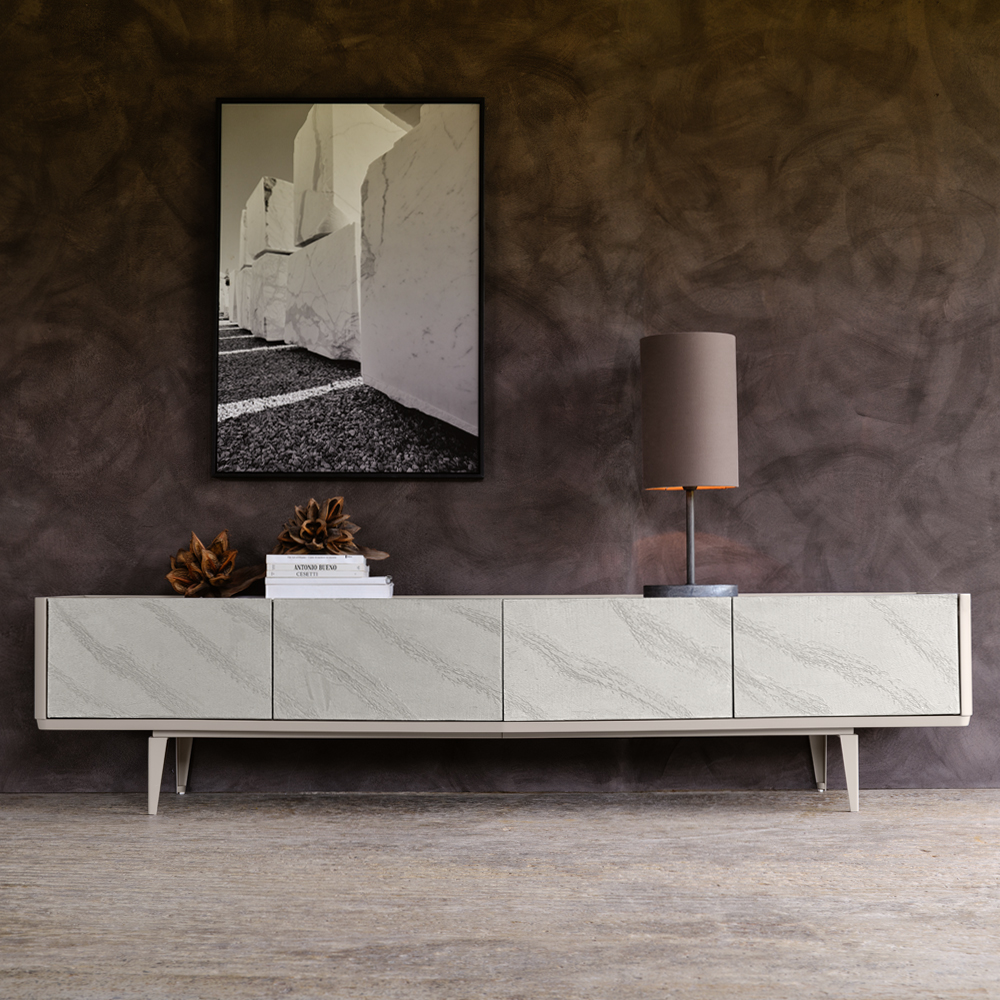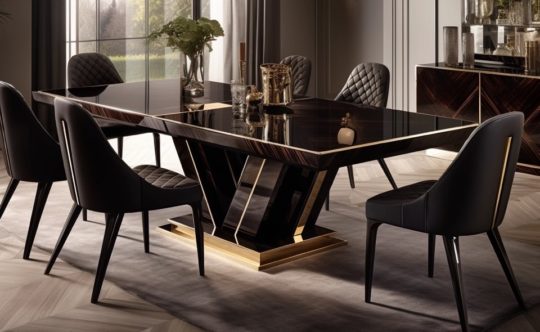
Interior design is an art form that goes beyond mere aesthetics; it aims to create spaces that are attractive, functional, and harmonious. A perfectly-balanced room has a sense of calm and comfort, enabling us to feel fully relaxed, whereas an unstable room can have quite the opposite impact. It’s not just about being easy on the eye, but the mind, also – which is why achieving equilibrium is an essential part of the process. Let’s delve into three fundamental approaches to balance: symmetrical, asymmetrical, and radial.
-
 Modern Abstract Upholstered Bed£12,165.00
Modern Abstract Upholstered Bed£12,165.00 -
 Oval Veneer 3 Door Buffet£19,050.00
Oval Veneer 3 Door Buffet£19,050.00
Symmetrical Balance
Symmetry is a simple, time-tested method of bringing balance to an interior. It involves mirroring elements on either side of a central axis, generating a sense of order. This is common for rooms with a single – often large – central object, such as bedrooms, dining rooms, and offices. Placing identical or similar elements on each side of the focal point helps to stabilise a room. Examples of these include a pair of nightstands, chairs, and uniform patterns on rugs or walls.
Symmetrical balance can evoke feelings of elegance, formality and tranquillity. As a result, it works perfectly in more uniformed environments, like traditional or neoclassical interiors, or grand architectural structures. Excessive amounts, however, can also be problematic, resulting in a static or predictable ambience. Therefore, it’s important to introduce some variations to maintain interest.
-
 Contemporary Round Crystal Mirror£13,050.00
Contemporary Round Crystal Mirror£13,050.00 -
 Large Chaise Art Deco Style Sofa£35,215.00
Large Chaise Art Deco Style Sofa£35,215.00 -
 Modern Cocktail Cabinet£9,859.00
Modern Cocktail Cabinet£9,859.00 -
 Luxury Marble Table Lamp£1,815.00
Luxury Marble Table Lamp£1,815.00
Asymmetrical Balance
Asymmetry is a dynamic, contemporary, and slightly more complex approach. Unlike symmetry, it doesn’t rely on strict mirroring, but instead carefully arranged objects, colours, and textures for a harmonious composition. This principle encourages creativity, individuality, and a feeling of movement by distributing visual weight unevenly, in a way that feels stable. It entails piecing together objects of different sizes, shapes and colours to attain an overall sense of equilibrium. For instance, a large piece of furniture on one side of a room can be counterbalanced by a series of smaller items on the opposite side.
Asymmetry presents an excellent opportunity for experimentation, and is great for energising any environment through elements of surprise or visual tension. And it’s this versatility that makes it an excellent design choice for both minimalist and maximalist interiors.
-
 Modern Low Sideboard With Drawers£8,100.00
Modern Low Sideboard With Drawers£8,100.00 -
 Modern Murano Glass Floor Lamp£1,922.00 – £2,306.00
Modern Murano Glass Floor Lamp£1,922.00 – £2,306.00 -
 High End Designer Two-Tone Leather Sofa£14,326.00
High End Designer Two-Tone Leather Sofa£14,326.00 -
 Modern Italian Designer Veneer Executive Desk£9,384.00
Modern Italian Designer Veneer Executive Desk£9,384.00
Radial Balance
Less common than symmetry and asymmetry, radial balance centres around a focal point and works outwards. It’s often associated with circular or rounded designs, such as tables, spiral staircases, and rugs or decorative ceilings. The idea is to draw the attention to the centre of a room, arranging surrounding elements symmetrically for a strong – yet unified – visual impact. This could look like a chandelier suspended above a dining table, or a curved sofa set encompassing a large pouffe.
Radial balance can add drama and movement to a space, making it ideal for large, open areas like hallways and living rooms. Despite this, it requires careful planning and consideration in order to avoid overwhelm or overcrowding.
-
 Modern Marble Round Coffee Table£4,190.00
Modern Marble Round Coffee Table£4,190.00 -
 Large Modern Ribbed Veneer Dining Table£16,310.00 – £17,735.00
Large Modern Ribbed Veneer Dining Table£16,310.00 – £17,735.00 -
 Luxury Round Bouclé Pouffe£3,350.00 – £4,610.00
Luxury Round Bouclé Pouffe£3,350.00 – £4,610.00 -
 Large Contemporary Stairwell Chandelier£1,083.00 – £7,348.00
Large Contemporary Stairwell Chandelier£1,083.00 – £7,348.00
When it comes to interior design, balance is non-negotiable. By understanding the three main approaches – symmetrical, asymmetrical, and radial – you can bring harmony to any space. Whether you prefer a classic, contemporary, or unconventional style, adopting these principles will undoubtedly elevate both the look and feel of your home.
We’re Here to Help
If you need help choosing your luxury furniture, our design team is always on hand. For advice on sizes, colours, fabrics and finishes, or to design the perfect space for you, contact us. Alternatively, you can pop into our Chelsea showroom – we would love to meet you.














